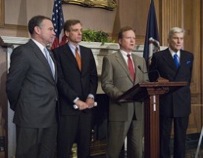
November 20, 2008 - Governor Tim Kaine, Senator-elect Mark Warner, and Senators Webb and John Warner hold a press conference calling on the Navy to delay its decision to create a second East Coast homeport for a nuclear-powered aircraft carrier at Mayport
Visit the Photo Gallery!
Recent decisions announced by the Department of Defense—including a call to disestablish the U.S. Joint Forces Command and a proposal to relocate a nuclear-powered aircraft carrier from Naval Station Norfolk—have significant strategic and fiscal consequences for our nation’s defense, as well as for our local Virginia communities. As a member of the Armed Services Committee and a former Secretary of the Navy, I have deep concerns with the lack of an adequate analytical framework for these decisions. I have fought to have them reevaluated through oversight hearings, legislation, and direct calls to the administration.
For the past four decades, Naval Station Norfolk has served as the East Coast homeport for the Navy’s nuclear-powered aircraft carriers assigned to the U.S. Atlantic Fleet, yet in January 2009, the Secretary of the Navy announced a proposal to relocate a nuclear-powered aircraft carrier from Naval Station Norfolk to a new homeport in Mayport, Florida.
As both a member of the Senate Committee on Armed Services and a former Secretary of the Navy, I remain convinced that there is no reasonable justification for the relocation of an aircraft carrier to Mayport and the construction of redundant nuclear-support facilities there when the Navy has identified growing readiness risks in its warfighting and shore-installation programs.
I fully support the Navy’s need to sustain the viability of Naval Station Mayport and its adjoining ship maintenance and repair industrial base, but homeporting non-nuclear ships, such as Littoral Combat Ships, would cost far less, pose fewer logistical and operating challenges, better match required ship maintenance with industrial-base capabilities in the region, and be more responsive to the operational needs of the U.S. Southern Command.
In June 2010, the Secretary of the Navy had this to say about the challenging fiscal environment he faces: "In the end, it’s about using our resources a lot more wisely. Because the long-term ability of the Navy and Marine Corps to support America’s broader foreign policy objectives, to remain the strategic leader in the world ... depends on our ability to adequately resource our fleet."
As I told the Secretary at the time, any decision to expend scarce resources to homeport a nuclear-powered aircraft carrier at Mayport must be considered within this context. Is it more important to create a duplicative, expensive homeporting capability than it is to build two or three additional Littoral Combat Ships? Is it more important to build redundant nuclear maintenance facilities at NS Mayport than it is to properly maintain and recapitalize the Navy’s four aging and increasingly antiquated naval shipyards when the Navy's backlog in repair and modernization requirements grew from $3 billion in FY2009 to $3.5 billion in FY2010?
I do not believe it is, and for this reason I will continue to work with my colleagues in Congress to reverse the Navy’s proposal to establish a duplicative and unnecessary nuclear-powered aircraft carrier homeport at Mayport and to ensure that programmed resources are allocated to other higher priority Navy requirements.
